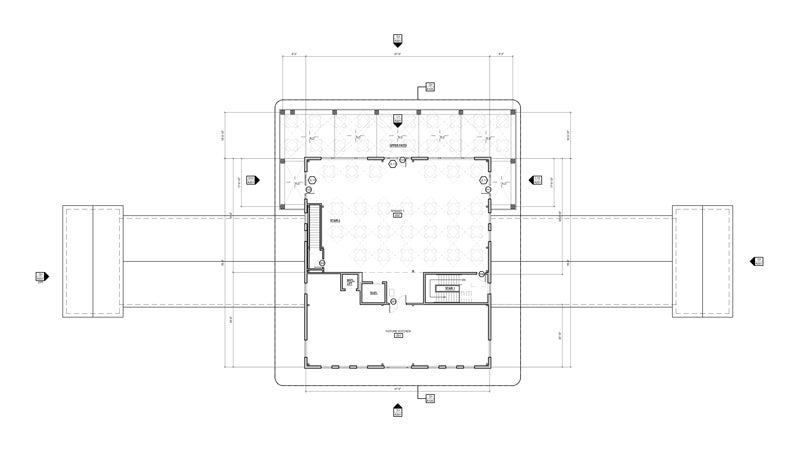Task force favors moving farmers market to ‘Grange’ development
Published 4:09 pm Friday, August 5, 2022
Town and county officials are on board with moving the Smithfield Farmers Market to former Smithfield Foods Chairman Joseph W. Luter III’s proposed “Grange at 10Main” development, but haven’t settled on what, if any, dollar amount to contribute to the project.
Luter has offered land and a $1 million contribution toward building a permanent home for the market, which would anchor his planned 56.8-acre mixed-use development, named for its location at Route 10 and Main Street at the western edge of the town’s historic district. The offer is conditional on Smithfield and Isle of Wight County jointly raising another $2.7 million.
Isle of Wight supervisors formed an intergovernmental task force five months ago for the purpose of evaluating the costs versus benefits of Luter’s offer. The group, which includes Supervisors Rudolph Jefferson and Dick Grice, Town Council members Renee Rountree and Wayne Hall, Isle of Wight Commissioner of the Revenue Gerald Gwaltney, Isle of Wight Economic Development Authority member Carroll Keen and Isle of Wight Economic Development Director Chris Morello, met for the first time on Aug. 3.
County Administrator Randy Keaton, Assistant County Administrator Don Robertson, Town Manager Michael Stallings, Smithfield-Isle of Wight Tourism Director Judy Winslow, County Attorney Bobby Jones and Town Attorney William Riddick III also attended.
The meeting opened with Winslow briefing the group on the limitations of the farmers market’s current seasonal home in the parking lot of the Bank of Southside Virginia on Main Street. The market’s five-year lease with the bank is set to expire this year.
“I have subsequently asked them multiple times for an answer to a renewal of this lease and we have not received an answer,” Winslow said.
The market, which operates weekly on Saturday mornings from March through October, currently receives around 75 applications from prospective vendors each week, but according to Winslow can accommodate only 45 to 50. It also lacks bathrooms, parking and can only provide electrical connections for roughly half of the vendors.
As of July 25, Luter’s preliminary “Grange” plans called for an indoor/outdoor farmers market with 24 roughly 113-square-foot indoor vendor booths and four roughly 348-square-foot walled-off storefronts. December 2021 plans called for additional covered booths and open space outdoors. The more than 13,000-square-foot building would also include indoor bathrooms and one or two restaurants.
“This would be literally a business incubator,” Winslow said.
The December plans also called for three- and four-story apartment buildings, single-family and duplex homes, a hotel, commercial space and over 1,000 parking spaces.
Luter has yet to submit a formal application to the town for rezoning or permits for the proposed construction. Riddick, who represented Luter in his 2020 purchase of the now-demolished Little’s Supermarket and 1730s-era Pierceville homestead where the Grange would be located, noted the town didn’t have a zoning option for the Grange until July when Smithfield’s Town Council amended its zoning ordinance to allow mixed-use developments.
According to Winslow, the currently outdoor farmers market took in just over $35,000 in vendor fees during the past year – just enough to break even with the expense of running the event.
“I think it’s pretty given that the Bank of Southside is not going to continue the farmers market,” Hall said.
According to a fiscal impact study prepared by Ted Figura Consulting for Luter’s LSMP LLC holding company, Luter is requesting the town and county not only “purchase and operate” the new farmers market but also “provide an economic development incentive” for the hotel, and “purchase the development’s infrastructure and utilities through a participation agreement.”
“It is confidently projected that The Grange at 10Main will generate sufficient revenue to support this public participation, after all variable costs of government service to the new development are paid,” the study states.
For the county, the study projects annual revenues of $1.1 million and annual costs of just over $581,000 during the development’s “stabilization period,” resulting in a 1.9-to-1 benefit-to-cost ratio. During the same stabilization period, the study projects annual town revenues of nearly $260,500, resulting in a 2.57-to-1 benefit-to-cost ratio for Smithfield.
But some task force members, Rountree among them, are still on the fence about whether to recommend the town and county each put over $1 million in taxpayer money toward the project.
“There are ways to make this more affordable,” Rountree said.
The rent paid by the one or two restaurants, Riddick said, would be “what funds it.”
“If you cheap it, and you make it less than what a commercial entity is going to want to be successful, then they’re not going to do it and this fails. … It’s got to be a focal point,” Riddick said.
Grice called for looking beyond the point of profitability when deciding on what if any amount of taxpayer money to contribute to Luter’s project, noting the town’s and county’s jointly operated Isle of Wight County Museum on Main Street isn’t a money-maker.
“A pure business decision would tell us to close the museum,” Grice said.
Winslow said she’d secured $50,000 in grant funding for the farmers market.
“There are lots of opportunities, but they’re not all huge monetary opportunities. … As far as big money is concerned, that might be more difficult,” Morello said.
Grice then called for any “very serious” candidates interested in renting the restaurant space to present their plans to the task force at a future meeting. Smithfield Town Council member Randy Pack recused himself in February from any future vote on the Grange once a formal application is made, noting he and his brother, Brian, are among the interested parties in the proposed restaurant space. The Pack brothers currently co-own and operate Smithfield Station restaurant, hotel and marina and a similar establishment in Surry County named Surry Seafood Co.
The Grange’s December rendering showed the proposed farmers market building in a brick, colonial style. The July rendering shows the building in a style more similar to the 19th and early 20th century storefronts that currently line Main Street.
“We’re in the driver’s seat here. … If we want to do this, I think we decide how much money we want to put for this, and then the building’s designed for what we can accommodate,” Winslow said.








